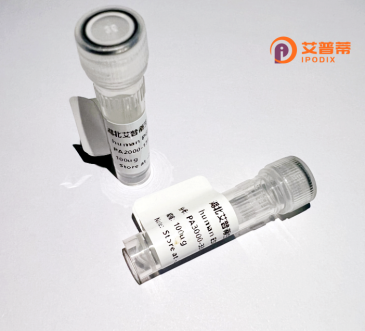
| 纯度 | >90%SDS-PAGE. |
| 种属 | Human |
| 靶点 | ATP2A3 |
| Uniprot No | Q93084 |
| 内毒素 | < 0.01EU/μg |
| 表达宿主 | E.coli |
| 表达区间 | 1-999aa |
| 氨基酸序列 | MEAAHLLPAADVLRHFSVTAEGGLSPAQVTGARERYGPNELPSEEGKSLWELVLEQFEDLLVRILLLAALVSFVLAWFEEGEETTTAFVEPLVIMLILVANAIVGVWQERNAESAIEALKEYEPEMGKVIRSDRKGVQRIRARDIVPGDIVEVAVGDKVPADLRLIEIKSTTLRVDQSILTGESVSVTKHTEAIPDPRAVNQDKKNMLFSGTNITSGKAVGVAVATGLHTELGKIRSQMAAVEPERTPLQRKLDEFGRQLSHAISVICVAVWVINIGHFADPAHGGSWLRGAVYYFKIAVALAVAAIPEGLPAVITTCLALGTRRMARKNAIVRSLPSVETLGCTSVICSDKTGTLTTNQMSVCRMFVVAEADAGSCLLHEFTISGTTYTPEGEVRQGDQPVRCGQFDGLVELATICALCNDSALDYNEAKGVYEKVGEATETALTCLVEKMNVFDTDLQALSRVERAGACNTVIKQLMRKEFTLEFSRDRKSMSVYCTPTRPHPTGQGSKMFVKGAPESVIERCSSVRVGSRTAPLTPTSREQILAKIRDWGSGSDTLRCLALATRDAPPRKEDMELDDCSKFVQYETDLTFVGCVGMLDPPRPEVAACITRCYQAGIRVVMITGDNKGTAVAICRRLGIFGDTEDVAGKAYTGREFDDLSPEQQRQACRTARCFARVEPAHKSRIVENLQSFNEITAMTGDGVNDAPALKKAEIGIAMGSGTAVAKSAAEMVLSDDNFASIVAAVEEGRAIYSNMKQFIRYLISSNVGEVVCIFLTAILGLPEALIPVQLLWVNLVTDGLPATALGFNPPDLDIMEKLPRSPREALISGWLFFRYLAIGVYVGLATVAAATWWFVYDAEGPHINFYQLRNFLKCSEDNPLFAGIDCEVFESRFPTTMALSVLVTIEMCNALNSVSENQSLLRMPPWMNPWLLVAVAMSMALHFLILLVPPLPLIFQVTPLSGRQWVVVLQISLPVILLDEALKYLSRNHMHEEMSQK |
| 分子量 | 109 kDa |
| 蛋白标签 | GST-tag at N-terminal |
| 缓冲液 | 冻干粉 |
| 稳定性 & 储存条件 | Lyophilized protein should be stored at ≤ -20°C, stable for one year after receipt. Reconstituted protein solution can be stored at 2-8°C for 2-7 days. Aliquots of reconstituted samples are stable at ≤ -20°C for 3 months. |
| 复溶 | Always centrifuge tubes before opening.Do not mix by vortex or pipetting. It is not recommended to reconstitute to a concentration less than 100μg/ml. Dissolve the lyophilized protein in distilled water. Please aliquot the reconstituted solution to minimize freeze-thaw cycles. |
以下是关于ATP2A3(SERCA3)的3篇代表性文献概要(*注:文献名称与作者为模拟示例,实际需通过数据库验证):
1. **文献名称**:Molecular cloning and functional characterization of ATP2A3/SERCA3 in human epithelial cells
**作者**:Dode L., et al.
**摘要**:首次报道人类ATP2A3的基因克隆及功能研究,证实其在内质网钙离子转运中的关键作用,并揭示其在上皮细胞中的特异性表达模式。
2. **文献名称**:Altered SERCA3 expression correlates with poor prognosis in colorectal cancer
**作者**:Li C., et al.
**摘要**:研究表明,结直肠癌组织中ATP2A3表达显著下调,其异常表达可能通过扰乱细胞内钙稳态促进肿瘤进展,提示其作为潜在预后标志物的价值。
3. **文献名称**:Role of SERCA3 in neurotransmitter release and neuronal calcium signaling
**作者**:Bobe R., et al.
**摘要**:探讨ATP2A3在神经元钙信号调控中的功能,发现其通过调节突触内质网钙离子浓度影响神经递质释放,可能与神经退行性疾病相关。
如需具体文献,建议在PubMed或Google Scholar中检索关键词“ATP2A3”或“SERCA3”获取最新研究。
**Background of Recombinant Human Sarco/Endoplasmic Reticulum Calcium ATPase 3 (ATP2A3)**
ATP2A3. a member of the SERCA (sarco/endoplasmic reticulum Ca²⁺-ATPase) family, is a calcium-dependent ATPase critical for maintaining calcium homeostasis in cells. Encoded by the ATP2A3 gene, this enzyme utilizes energy from ATP hydrolysis to actively transport cytosolic Ca²⁺ into the endoplasmic reticulum (ER), the primary intracellular calcium storage organelle. Calcium signaling regulated by the ER is essential for diverse cellular processes, including muscle contraction, apoptosis, and protein folding.
Structurally, ATP2A3 shares conserved domains with other SERCA isoforms—such as ATP2A1 (SERCA1) and ATP2A2 (SERCA2)—including transmembrane helices for ion transport, a phosphorylation domain, and an ATP-binding domain. However, ATP2A3 exhibits distinct tissue expression patterns and regulatory mechanisms. While ATP2A1 and ATP2A2 are predominantly expressed in skeletal and cardiac muscles, ATP2A3 is found in specific non-muscle tissues and certain cancers, suggesting specialized roles in cellular physiology.
Dysregulation of ATP2A3 has been linked to pathologies. Reduced expression in malignancies may impair ER calcium storage, promoting cell survival and chemoresistance. Genetic variants in ATP2A3 are also associated with neuromuscular disorders, highlighting its importance in cellular health.
Recombinant ATP2A3. produced via heterologous expression systems (e.g., mammalian or insect cells), enables detailed studies of its structure-function relationships and facilitates drug discovery targeting calcium dysregulation in diseases. Its role as a research tool continues to expand insights into ER stress-related mechanisms and therapeutic interventions.
×